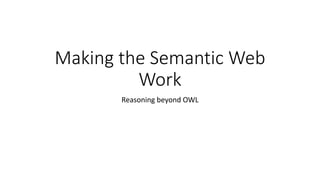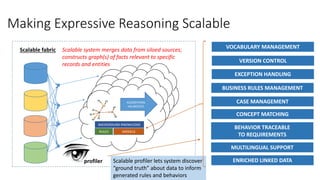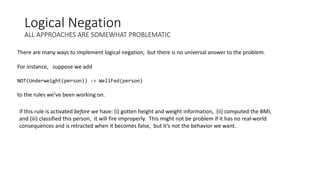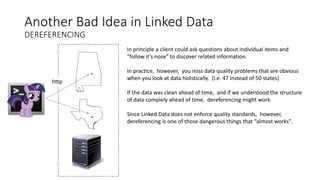The document discusses the challenges and advancements in making the Semantic Web more practical, particularly focusing on the semantic issues in machine-to-machine communication and the importance of structured processes linking specifications to implementations. It critiques current RDF standards and highlights the need for scalable solutions such as RDF* and SPARQL*, emphasizing the evolution towards more effective data integration methods while maintaining human-readable formats. Additionally, it addresses the limitations of traditional semantic frameworks like OWL in data processing and inference capabilities.










![Predicate Calculus
RDF is a special case of the “predicate calculus”
Statement of arity 2
Predicate Calculus:
A(:Dog,:Fido)
RDF:
:Fido A :Dog .
Statement of arity 3
Predicate Calculus:
:Population(:Nigeria,2013,173.6e6)
RDF:
[
a :Population .
:where :Nigeria .
:when 2013 .
:amount 173.6e6
]
It’s not too hard to write this in
Turtle
This implementation, however,
is structurally unstable, since
we went from one triple to four
triples](https://image.slidesharecdn.com/makingthesemanticwebwork-151013183540-lva1-app6892/85/Making-the-semantic-web-work-11-320.jpg)


![The Old RDF: Expressive but not scalable
Early RDF:
RDF/XML serialization, heavy use of blank nodes, extreme
expressiveness:
[ a sp:Select ;
sp:resultVariables (_:b2) ;
sp:where ([ sp:object rdfs:Class ;
sp:predicate rdf:type ;
sp:subject _:b1
] [ a sp:SubQuery ;
sp:query
[ a sp:Select ;
sp:resultVariables (_:b2) ;
sp:where ([ sp:object _:b2 ;
sp:predicate rdfs:label ;
sp:subject _:b1
])
]
])
]
This is a representation of a SPARQL
query in RDF!
This example uses Turtle, where
square brackets create blank nodes
and parenthesis create lists.
With this graph in the JENA
framework you can easily manipulate
this as an abstract syntax tree.
Very complex relationships, such as
mathematical equations can be built
this way; blank nodes can be used to
write high-arity predicates.
Accessing it through SPARQL would
not be so easy!](https://image.slidesharecdn.com/makingthesemanticwebwork-151013183540-lva1-app6892/85/Making-the-semantic-web-work-14-320.jpg)
![Linked Data: New Focus
Linked data source
Blank nodes are discouraged because it’s hard for
a distributed community to talk about something
without a name.
[ a sp:Select ;
sp:resultVariables (_:b2) ;
sp:where ([ sp:object rdfs:Class ;
sp:predicate rdf:type ;
sp:subject _:b1
] [ a sp:SubQuery ;
sp:query
[ a sp:Select ;
sp:resultVariables (_:b2) ;
sp:where ([ sp:object _:b2 ;
sp:predicate rdfs:label ;
sp:subject _:b1
])
]
])
]
Turtle and RDF/XML (which
have sweet syntax for blank
nodes) are not scalable
because the parser cannot be
restarted after a failure: if
you have billions of triples, a
few will be bad
<http://example.org/show/218> <http://www.w3.org/2000/01/rdf-schema#label> "That Seventies Show"^^<http://www.w3.org/2001/XMLSchema#string> .
<http://example.org/show/218> <http://www.w3.org/2000/01/rdf-schema#label> "That Seventies Show" .
<http://example.org/show/218> <http://example.org/show/localName> "That Seventies Show"@en .
<http://example.org/show/218> <http://example.org/show/localName> "Cette Série des Années Septante"@fr-be .
<http://example.org/#spiderman> <http://example.org/text> "This is a multi-linenliteral with many quotes (""""")nand two apostrophes ('')." . <http://en.wikipedia.org/wiki/Helium>
<http://example.org/elements/atomicNumber> "2"^^<http://www.w3.org/2001/XMLSchema#integer> . <http://en.wikipedia.org/wiki/Helium> <http://example.org/elements/specificGravity> "1.663E-
4"^^<http://www.w3.org/2001/XMLSchema#double> .
N-Triples is practical for large databases such as Freebase and Dbpedia because records are
isolated, but blank nodes must be named, triple-centric modelling is encouraged
We now have a great query language, SPARQL. SPARQL supports the
same shorthand for blank nodes as Turtle. Some blank node patterns
work naturally, but it is particularly hard to ask questions about
ordered collections.
Blank nodes, collections, etc. are out of fashion.](https://image.slidesharecdn.com/makingthesemanticwebwork-151013183540-lva1-app6892/85/Making-the-semantic-web-work-15-320.jpg)

![Old Approaches to Reificiation
Reification with Blank Nodes
[
rdf:type rdf:Statement .
rdf:subject :Tolkien .
rdf:predicate :wrote .
rdf:object :LordOfTheRings .
:said :Wikipedia .
]
http://stackoverflow.com/questions/1312741/simple-example-of-reification-in-rdf
This isn’t too hard to write in Turtle, but it breaks
SPARQL queries and inference for reified triples.
The number of triples is at the very least tripled; the
triple store is unlikely to be able to optimize for
common use cases.](https://image.slidesharecdn.com/makingthesemanticwebwork-151013183540-lva1-app6892/85/Making-the-semantic-web-work-17-320.jpg)
























![What about SPIN?
SPIN is similar in expressiveness to production rules.
ex:Person
a rdfs:Class ;
rdfs:label "Person"^^xsd:string ;
rdfs:subClassOf owl:Thing ;
spin:rule
[ a sp:Construct ;
sp:text """
CONSTRUCT {
?this ex:grandParent ?grandParent .
}
WHERE {
?parent ex:child ?this .
?grandParent ex:child ?parent .
}"""
] .
This is like a production rule written in
reverse, we infer triples from the
CONSTRUCT clause based on matching
the WHERE clause.
TopBraid Composer implements most
inference through primitive forward
chaining (a fixed point algorithm, RETE
cannot be used because the order of
rule firing is unpredictable.)
Backwards chaining can be
accomplished through the definition of
“magic properties” (something similar
can be done with Drools too)
SPIN has support for query templates, in some ways like Decision
Tables but possibly more palatable for coders and for semantic apps
Control of execution order, negation, and non-monotonic
reasoning are not settled. Less is know about how to implement it](https://image.slidesharecdn.com/makingthesemanticwebwork-151013183540-lva1-app6892/85/Making-the-semantic-web-work-42-320.jpg)








![Yet, some RDF syntaxes look almost the same
as JSON/XML
JSON
{
missions: [ “Mercury”, “Gemini”, “Apollo” ]
}
TURTLE
:Missions :members (:Mercury,:Gemini,:Apollo) .
Most RDF tools will expand this into a LISP-list
with blank nodes, but in TURTLE format the
physical layout is the same as JSON.
Collections and Containers are described as “non-
normative” in RDF 1.1; advanced tools may use
special efficient representations (like would be used for
JSON).
It’s awkward to work with ordered collections in the
common “client-server” model that revolves around
SPARQL engines, but for small graphs in memory, the
situation is different – the Jena framework provides a
facility for accessing Collections that feels a lot like
accessing data in JSON
Ordered collections are critical for dealing with external data
that supports external collections AND critical for many
traditional RDF use cases such as metadata (you’ll find
scientists are pretty sensitive to the order of authors for a
paper)](https://image.slidesharecdn.com/makingthesemanticwebwork-151013183540-lva1-app6892/85/Making-the-semantic-web-work-51-320.jpg)






